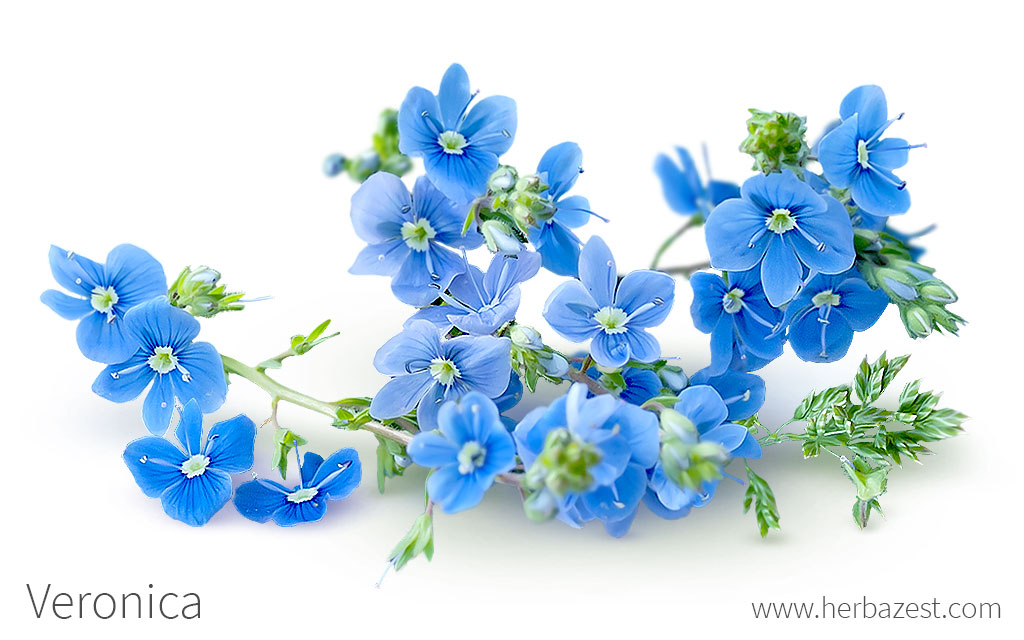The veronica plant (Veronica officinalis), originally from Europe and Western Asia, gained its popularity thanks to its various healing properties. Though it has been an ingredient for alcoholic beverages throughout history, it is nowadays predominantly used in herbal remedies due to its medicinal value.
Veronica Medicinal Properties
Health Benefits of Veronica
The veronica plant, or speedwell, is primarily known for its anti-inflammatory properties; however, this medicinal actions have not been studied until recently, and scientific research is still revealing possible applications for this herb. The main benefits of veronica include:
Relieving inflammatory pain. Veronica officinalis has been traditionally used to treat health conditions that involve systemic inflammation, mainly the pain caused by rheumatism and arthritis.
Treating respiratory diseases. Because of its antibacterial and anti-inflammatory properties, folk uses of veronica include treating asthma, cough, and other conditions that affect lungs.
Speeding wound healing. Due to its antioxidant and antimicrobial actions, speedwell has been traditionally applied topically in order to disinfect wounds, speed up healing, and calm skin irritations.
Additionally, all parts of the veronica plant have been traditionally used to treat allergies and insomnia as well as urinary tract, liver problems, and gastrointestinal issues.
VERONICA IS THOUGHT TO BE A METABOLIC BOOSTER THAT STIMULATES SWEATING, AND IT HAS BEEN TRADITIONALLY CONSUMED AS A "BLOOD PURIFIER."
How it Works
The most important micronutrients in speedwell are iridoid glycosides, in particular verproside and the unique veronicoside, as well as flavonoids and organic acids. These compounds have been shown to exert antimicrobial and anti-inflammatory activities.1
The folk uses of speedwell for the treatment of respiratory problems, such as asthma, cough and other lung diseases, can be explained by the inhibitory actions of iridoid glycosides over proinflammatory mediators in lung cells.2
Almost equally significant is the high concentration of astringent tannins in Veronica officinalis, which make this herb potentially useful for treating minor bleeding and diarrhea.3 These beneficial herbal compounds render veronica tea a useful aid for a broad spectrum of health conditions.
Other herbs with anti-inflammatory properties, widely consumed to relieve joint pain, are turmeric and cat's claw, whereas eucalyptus and jasmine are commonly used for the treatment of respiratory problems.
Veronica Side Effects and Cautions
There are no reports of veronica's side effects, and this herb is considered safe in adequate amounts when taken orally as a medicine. There is not enough information about the effects of veronica during pregnancy and lactation, so caution is advised.
- Medicinal action Anti-inflammatory
- Key constituents Iridoid glycosides, flavonoids, tannins
- Ways to use Capsules, Hot infusions/tisanes, Liquid extracts, Tincture, Poultice, Essential oil
- Medicinal rating (2) Minorly useful plant
- Safety ranking Safe

How to Consume Veronica
Natural forms
Infusion. Veronica plant's upper parts, flowers, and leaves, are commonly brewed into an herbal infusion that can be consumed medicinally in order to soothe cough, internal ulcers, systemic inflammation, and many other illnesses.
Poultice. The whole veronica plant, including the root, can be boiled, drained, and wrapped in gauze to be used as a warm compress for the relief of stomach pain or joint inflammation.
Herbal Remedies & Supplements
Essential oil. The veronica plant has a mild fragrance that is commonly used in aromatherapy, in candles, and medicinal ointments, usually combined with other herbs.
Liquid extract. This herbal supplement is alcohol free and provides all benefits of veronica. Small amounts can be diluted in water to treat conditions from arthritic and joint pain to gastrointestinal and respiratory problems, urinary tract infections, and more.
Tincture. The upper parts of the herb are submerged and marinated in a neutral alcohol in order to concentrate their medicinal properties. A few drops, diluted in a glass of water or a warm beverage, will be enough to obtain the health benefits of speedwell.
Capsules. The dried and powdered flowers and leaves of veronica plant are made into capsules that provide standardized doses and are easy to take as a supplement.
- Edible uses Beverage

Growing
Veronica, also known as common speedwell, gypsyweed, and Paul's betony, among other popular names, is an easy-to-grow, perennial shrub that can be spotted in most parks, roadsides, and landscaped areas across temperate regions. It also grows wild in deciduous forests. The veronica plant requires only basic conditions to thrive, including relatively fertile soil, with a good drainage system, and adequate sun exposure.
Growing Guidelines
The shrub grows directly from seed, without the need of any pre-germination process, although it is recommended to sow it in nurseries first and then transplant it to the final field afterwards.
The best time for growing veronica is during cool summers. The plant requires partial shade to full sun conditions, as well as slightly acidic or slightly alkaline soil to grow to its optimal potential.
In order to ensure proper growth, the seedlings should be planted in rows, one to two feet (30 - 60 cm) apart, in deeply plowed soil 15 inches (38 cm) deep.
Care should be taken to periodically check on the speedwell plants, because they spread really quickly and can take over a garden.
The veronica plant is notoriously hardy and is not susceptible to any particular pest or disease.
- Life cycle Perennial
- Harvested parts Flowers, Seeds, Leaves
- Light requirements Full sun, Partial shade
- Soil Well-drained
- Soil pH 6.1 – 6.5 (Slightly acidic), 6.6 – 7.3 (Neutral), 7.4 – 7.8 (Slightly alkaline)
- Growing habitat Temperate climates
- Planting time Early spring, Summer
- Plant spacing average 0.6 m (1.97 ft)
Additional Information
Plant Biology
Veronica officinalis goes by many popular names, such as common veronica, speedwell, common gypsyweed, and Paul's betony, among many others. It is a perennial, bushy species, which spreads easily and can grow as tall as 2 – 10 inches (5 – 10 cm). The veronica plant shows hairy, green, erect branches, with opposite leaves, oval to elliptical, finely toothed, which are usually 1 ½ – 3 times as long as wide. Common speedwell flowers are unassuming and light-blue colored, with four petals that compose a tubular shape, and grow in spike-like clusters from the upper leaf axils. Veronica seeds are triangular.
Classification
Veronica officinalis is a member of the Plantaginaceae family, which comprises about 1,700 species of flowering plants, notably including other medicinal herbs, such as greater plantain (Plantago major), psyllium (Plantago afra), and turtlehead (Chelone oblique).
Varieties and Subspecies
Veronica is the largest genus within the Plantaginaceae family, containing about over 500 species of annual and perennial plants. There are many types of veronica plants, most of them used for agricultural and ornamental purposes; however, Veronica officinalis, popularly known as common veronica, speedwell, common gypsyweed, and Paul's betony, is the one generally used for herbal remedies.
Historical Information
Originally from Europe and West Asia, the veronica plant was used as a tea and health tonic in England approximately 500 years ago. Although it has been adapted for growth throughout the world, its natural habitat consisted of temperate regions. The importance of speedwell throughout history is due to the medicinal qualities it was thought to have. European countries also popularized it when it was used as a substituted for tea. In modern times, it has been used in herbal medicine by brewing the dried flowering plant.
Popular Beliefs
The name of the genus, Veronica, established by Linnaeous in the 18th century, as well as one of its oldest popular name in Europe, Paul's betony, share the same origin, rooted in Christian folklore. It was a common belief among medieval flower lovers that the handkerchief used by a maiden to clean Jesus' face on his way to the Calvary was scented with betony fragrance (Betonica officinalis, later known, by transliteration, as Veronica). That handkerchief became one of the most precious relics visited by pilgrims in Rome, and the plant that commonly grows along the roads was named after St. Paul, the apostle.
Economic Data
Although production of Veronica officinalis has declined since its European tea heyday, it may regain popularity and economic importance due to the discovery that many of its components may act as anti-inflammatory, expectorant, and antimicrobial agents. Currently, North America is one of its largest producers. In addition, a minor slice of its economic importance derives from its value as an ornamental plant.
Other Uses
Ornamental. Because of their pretty, unassuming flowers, different types of veronica can be seen in gardens and landscapes.
Alcohol. Veronica has also been used extensively in the alcohol industry, namely during the brewing of absinthe.
Perfumery and aromatherapy. The subtle fragrance of speedwell flowers is used as a base for perfumes and scented candles.
Agriculture. Speedwell is a common rotating crop, often cultivated by farmers, the same way as alfalfa.
- Other uses Alcohol, Perfume
Sources
- Farmers' Almanac, Veronica cultivation information
- Frontiers in Pharmacology, Veronica officinalis Product Authentication Using DNA Metabarcoding and HPLC-MS Reveals Widespread Adulteration with Veronica chamaedrys, 2017
- Industrial Crops and Products, Phenolic profile and anti-inflammatory activity of three Veronica species, 2015
- Midwest Invasive Species Information Network - MISIN, Common gypsyweed (Veronica officinalis)
- Molecules, Veronica Plants—Drifting from Farm to Traditional Healing, Food Application, and Phytopharmacology, 2019
- Perennial All-Stars: The 150 Best Perennials for Great-Looking, Trouble-Free Gardens, p. 314
- Spices and Herbs: Lore and Cookery
- University of Michigan Health, Native American Ethnobotany Database: Veronica officinalis
- Wildflowers of the Eastern United States, p. 139
- USDA Plants Database, Plant profile for Veronica officinalis
- Medicinal Plants of the World
- Journal of Ethnopharmacology, Ethnopharmacological in vitro studies on Austria's folk medicine-an unexplored lore in vitro anti-inflammatory activities of 71 Austrian traditional herbal drugs, 2013
Footnotes:
- International Journal of Molecular Sciences. (2015). Phytochemical Characterization of Veronica officinalis L., V. teucrium L. and V. orchidea Crantz from Romania and Their Antioxidant and Antimicrobial Properties. Retrieved August 05, 2021 from https://www.ncbi.nlm.nih.gov/pmc/articles/PMC4613244/
- Journal of Etnophamacology. (2013). Traditionally used Veronica officinalis inhibits proinflammatory mediators via the NF-κB signalling pathway in a human lung cell line. Retrieved August 05, 2021 from https://pubmed.ncbi.nlm.nih.gov/23142555/
- Current Medical Chemistry, 2012. (2013). Anti-Inflammatory Iridoids of Botanical Origin. Retrieved August 05, 2021 from https://www.ncbi.nlm.nih.gov/pmc/articles/PMC3873812/






